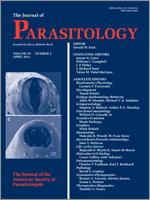Land-use alterations can have profound influences on faunal distributions, including host-parasite relationships. Yellow grub trematodes (Clinostomum spp.) have complex life cycles involving 3 hosts: a snail, a fish or amphibian, and a bird. Here, we analyze the distribution, prevalence, intensity, abundance, and genetic diversity of encysting metacercariae of Clinostomum spp. in salamanders and fishes throughout an aquatic system that includes a natural Ozark stream and man-made ponds. We found Clinostomum sp. infecting permanently aquatic Oklahoma salamanders (Eurycea tynerensis; 56% prevalence) and larval grotto salamanders (Eurycea spelaea) immediately downstream from a man-made pond. However, Clinostomum sp. did not infect any salamanders in the spring that supplies this pond, or in sections farther downstream (∼0.5 and 2 km). Metacercariae of Clinostomum sp. were present in ∼90% of introduced largemouth bass (Micropterus salmoides) in the man-made pond adjunct to the stream. Morphological examination and phylogenetic analyses based on the mitochondrial gene cytochrome oxidase 1 (Co1) and the nuclear ribosomal gene 18S show that fishes and salamanders at this site are primarily infected with Clinostomum marginatum. There is a relatively high degree of mitochondrial haplotype diversity in C. marginatum at this site but no consistent genetic difference between parasites in largemouth bass from the man-made pond and those in salamanders from the stream. Based on the microgeographic distribution and relationships of metacercariae of C. marginatum at this site, we hypothesize that the adjunct man-made pond has created an ecological situation that brings the cercariae of this parasite into contact with novel stream salamander hosts.
How to translate text using browser tools
1 April 2011
Distribution, Abundance, and Genetic Diversity of Clinostomum spp. Metacercariae (Trematoda: Digenea) in a Modified Ozark Stream System
Ronald M. Bonett,
Michael A. Steffen,
Ana L. Trujano-Alvarez,
Samuel D. Martin,
Charles R. Bursey,
Chris T. McAllister
ACCESS THE FULL ARTICLE

Journal of Parasitology
Vol. 97 • No. 2
April 2011
Vol. 97 • No. 2
April 2011




